Correlations and Numerical Modeling of Stacked Woven Wire-Mesh Porous Media for Heat Exchange Applications
Abstract
:1. Introduction
2. Problem Statement
3. Modeling and Arriving at Expressions for Stacked Woven Wire-Mesh Porous Samples
3.1. Determination of Interstitial Area Density or Specific Area
3.2. Cross-Relations between Porosity, Fiber Diameter and Pore Width
3.3. Interstitial Heat Transfer and Flow Resistance Coefficients
4. Numerical Simulation, Boundary Conditions, Computational Scheme and Governing Equations
Validation of the Numerical Solution
5. Results and Discussion
5.1. Interpretation of Results from the Expressions Arrived
5.2. Thermo-Hydraulic Analysis
6. Conclusions
Author Contributions
Funding
Acknowledgments
Conflicts of Interest
Nomenclature
| A | Surface area of Aluminum plate (m2) |
| Asm | Total area of the solid mesh in the whole porous block |
| a1 | Area of total solid fibers constituting an individual mesh layer |
| as | Area of straight running wire fiber (m2) |
| aw | Area of weaving wire fiber (m2) |
| asf | Area density (m−1) |
| C | Inertial resistance coefficient (m−1) |
| Cp | Specific heat (J/kgK) |
| dp | Pore diameter (m) |
| df | Fiber diameter (m) |
| dh | Hydraulic diameter |
| hwall | Wall heat transfer coefficient (W/m2 K) |
| hsf | Interstitial heat transfer coefficient (W/m2 K) |
| h | Spacing (distance) between individual mesh layers. |
| Hmin | Minimum possible distance measured from centre to centre of straight running fibres of consecutive mesh layers for closely packed condition |
| K | Permeability (m2) |
| 1/K | Viscous resistance coefficient (inverse of permeability) |
| k | Dimensionless ratio (df/dp) |
| Nu | Nusselt number |
| MPI | Mesh per inch |
| Ns | Number of straight running wire fibers |
| Nw | Number of weaving wire fibers |
| P | Pressure (N/m2) |
| Pr | Prandtl number of fluid |
| Q | Heat input (W) |
| Redh | Reynolds number based on hydraulic diameter |
| T | Temperature (K) |
| T∞ | Ambient temperature (K) |
| w | Pore width |
| Greek symbols | |
| ε | Porosity |
| ω | pore density |
| λ | Thermal conductivity (W/mK) |
| μ | Dynamic viscosity (N-s/m2) |
| v | Kinematic viscosity (m2/s) |
| ρ | Density (kg/m3) |
| Subscript | |
| f | Fluid |
| fe | Fluid effective |
| s | Solid |
| se | Solid effective |
References
- Donmus, S.; Mobedi, M.; Kuwahara, F. Double-layer metal foams for further heat transfer enhancement in a channel: An analytical study. Energies 2021, 14, 672. [Google Scholar] [CrossRef]
- Hossain, M.S.; Shabani, B. Experimental study on con fi ned metal foam fl ow passage as compact heat exchanger surface. Int. Commun. Heat Mass Transf. 2018, 98, 286–296. [Google Scholar] [CrossRef]
- Boyd, B.; Hooman, K. Air-cooled micro-porous heat exchangers for thermal management of fuel cells. Int. Commun. Heat Mass Transf. 2012, 39, 363–367. [Google Scholar] [CrossRef]
- Qureshi, Z.A.; Al-Omari, S.A.B.; Elnajjar, E.; Al-Ketan, O.; Al-Rub, R.A. Using triply periodic minimal surfaces (TPMS)-based metal foams structures as skeleton for metal-foam-PCM composites for thermal energy storage and energy management applications. Int. Commun. Heat Mass Transf. 2021, 124, 105265. [Google Scholar] [CrossRef]
- Odabaee, M.; Hooman, K. Application of metal foams in air-cooled condensers for geothermal power plants: An optimization study. Int. Commun. Heat Mass Transf. 2011, 38, 838–843. [Google Scholar] [CrossRef]
- Wang, F.; Guan, Z.; Tan, J.; Ma, L.; Yan, Z.; Tan, H. Transient thermal performance response characteristics of porous-medium receiver heated by multi-dish concentrator. Int. Commun. Heat Mass Transf. 2016, 75, 36–41. [Google Scholar] [CrossRef]
- Lotfizadeh, H.; Mehrizi, A.A.; Motlagh, M.S.; Rezazadeh, S. Thermal performance of an innovative heat sink using metallic foams and aluminum nanoparticles-Experimental study. Int. Commun. Heat Mass Transf. 2015, 66, 226–232. [Google Scholar] [CrossRef]
- Trilok, G.; Gnanasekaran, N. Numerical study on maximizing heat transfer and minimizing flow resistance behavior of metal foams owing to their structural properties. Int. J. Therm. Sci. 2021, 159, 106617. [Google Scholar] [CrossRef]
- Xiao, G.; Peng, H.; Fan, H.; Sultan, U.; Ni, M. Characteristics of steady and oscillating flows through regenerator. Int. J. Heat Mass Transf. 2017, 108, 309–321. [Google Scholar] [CrossRef]
- Zhao, J.; Sun, M.; Zhang, L.; Hu, C.; Tang, D.; Ynag, L.; Song, Y. Forced Convection Heat Transfer in Porous Structure: Effect of Morphology on Pressure Drop and Heat Transfer Coefficient. J. Therm. Sci. 2021, 30, 363–393. [Google Scholar]
- Kang, K.J. Wire-woven cellular metals: The present and future. Prog. Mater. Sci. 2015, 69, 213–307. [Google Scholar] [CrossRef]
- Sypeck, D.J.; Introduction, I. Multifunctional microtruss laminates: Textile synthesis and properties. J. Mater. Res. 2001, 16, 890–897. [Google Scholar]
- Tian, J.; Lu, T.J.; Hodson, H.P.; Queheillalt, D.T.; Wadley, H.N.G. Cross flow heat exchange of textile cellular metal core sandwich panels. Int. J. Heat Mass Transf. 2007, 50, 2521–2536. [Google Scholar] [CrossRef]
- Costa, S.C.; Barrutia, H.; Esnaola, J.A.; Tutar, M. Numerical study of the pressure drop phenomena in wound woven wire matrix of a Stirling regenerator. Energy Convers. Manag. 2013, 67, 57–65. [Google Scholar] [CrossRef]
- Costa, S.C.; Barrutia, H.; Esnaola, J.A.; Tutar, M. Numerical study of the heat transfer in wound woven wire matrix of a Stirling regenerator. Energy Convers. Manag. 2014, 79, 255–264. [Google Scholar] [CrossRef]
- Bussière, W.; Rochette, D.; Clain, S.; André, P.; Renard, J.B. Pressure drop measurements for woven metal mesh screens used in electrical safety switchgears. Int. J. Heat Fluid Flow 2017, 65, 60–72. [Google Scholar] [CrossRef]
- Jadhav, P.H.; Trilok, G.; Gnanasekaran, N.; Mobedi, M. Performance score based multi-objective optimization for thermal design of partially filled high porosity metal foam pipes under forced convection. Int. J. Heat Mass Transf. 2022, 182, 121911. [Google Scholar] [CrossRef]
- Trilok, G.; Kumar, K.K.; Gnanasekaran, N.; Mobedi, M. Numerical assessment of thermal characteristics of metal foams of orderly varied pore density and porosity under different convection regimes. Int. J. Therm. Sci. 2022, 172, 107288. [Google Scholar] [CrossRef]
- Trilok, G.; Gnanasekaran, N.; Mobedi, M. Various Trade-Off Scenarios in Thermo-Hydrodynamic Performance of Metal Foams Due to Variations in Their Thickness and Structural Conditions. Energies 2021, 14, 8343. [Google Scholar] [CrossRef]
- Armour, J.C. Fluid Through Woven Screens. AIChE J. 1968, 14, 415–420. [Google Scholar]
- Garg, S.K.; Premachandran, B.; Singh, M. Numerical study of the regenerator for a miniature Stirling cryocooler using the local thermal equilibrium (LTE) and the local thermal nonequilibrium (LTNE) models. Therm. Sci. Eng. Prog. 2019, 11, 150–161. [Google Scholar] [CrossRef]
- Nam, K.; Jeong, S. Novel flow analysis of regenerator under oscillating flow with pulsating pressure. Cryogenics (Guildf). 2005, 45, 368–379. [Google Scholar] [CrossRef]
- Geodeon, D. Baseline Stirling Modeling; Gedeon Associates: Athens, OH, USA, 1999. [Google Scholar]
- Iwaniszyn, M.; Sindera, K.; Gancarczyk, A.; Korpy, M.; Roman, J.J.; Ko, A.; Jod, J. Experimental and CFD investigation of heat transfer and flow resistance in woven wire gauzes. Chem. Eng. Process.—Process. Intensif. 2021, 163, 108364. [Google Scholar] [CrossRef]
- Wang, Y.; Yang, G.; Huang, Y.; Huang, Y.; Zhuan, R.; Wu, J. Analytical model of flow-through-screen pressure drop for metal wire screens considering the effects of pore structures. Chem. Eng. Sci. 2021, 229, 116037. [Google Scholar] [CrossRef]
- Xu, J.; Tian, J.; Lu, T.J.; Hodson, H.P. On the thermal performance of wire-screen meshes as heat exchanger material. Int. J. Heat Mass Transf. 2007, 50, 1141–1154. [Google Scholar] [CrossRef]
- Zhao, Z.; Peles, Y.; Jensen, M.K. Properties of plain weave metallic wire mesh screens. Int. J. Heat Mass Transf. 2013, 57, 690–697. [Google Scholar] [CrossRef]
- Kurian, R.; Balaji, C.; Venkateshan, S.P. Experimental investigation of convective heat transfer in a vertical channel with brass wire mesh blocks. Int. J. Therm. Sci. 2016, 99, 170–179. [Google Scholar] [CrossRef]
- Kurian, R.; Balaji, C.; Venkateshan, S.P. An experimental study on hydrodynamic and thermal performance of stainless steel wire mesh blocks in a vertical channel. Exp. Therm. Fluid Sci. 2017, 86, 248–256. [Google Scholar] [CrossRef]
- Kotresha, B.; Gnanasekaran, N. Determination of interfacial heat transfer coefficient for the flow assisted mixed convection through brass wire mesh. Int. J. Therm. Sci. 2019, 138, 98–108. [Google Scholar] [CrossRef]
- Kaviany, M. Principles of Heat Transfer in Porous Media; Springer: New York, NY, USA, 1995. [Google Scholar]
- Wakao, N.; Kaguei, S.; Funazkri, T. Effect of fluid dispersion coefficients on particle-to-fluid heat transfer coefficients in packed beds: Correlation of nusselt numbers. Chem. Eng. Sci. 1979, 34, 325–336. [Google Scholar]
- Zukauskas, A. Convective Heat Transfer in Cross Flow. Handbook of Single-Phase Convective Heat Transfer; John Wiley &Sons: Hoboken, NJ, USA, 1987. [Google Scholar]
- Calmidi, V.V.; Mahajan, R.L. Forced convection in high porosity metal foams. J. Heat Transfer 2000, 122, 557–565. [Google Scholar] [CrossRef]
- Tanaka, M.; Yamashita, I.; Chisaka, F. Flow and heat transfer characteristics of the stirling engine regenerator in an oscillating flow. JSME Int. J. 1990, 33, 283–289. [Google Scholar]
- Gedeon, D.; Wood, J.G. Oscillating-Flow Regenerator Test Rig: Hardware and Theory with Derived Correlations for Screens and Felts; National Aeronautics and Space Administration: Washington, DC, USA, 1996. [Google Scholar]
- A F.U. Guide; Version 12; Ansys Inc.: Canonsburg, PA, USA, 2009.
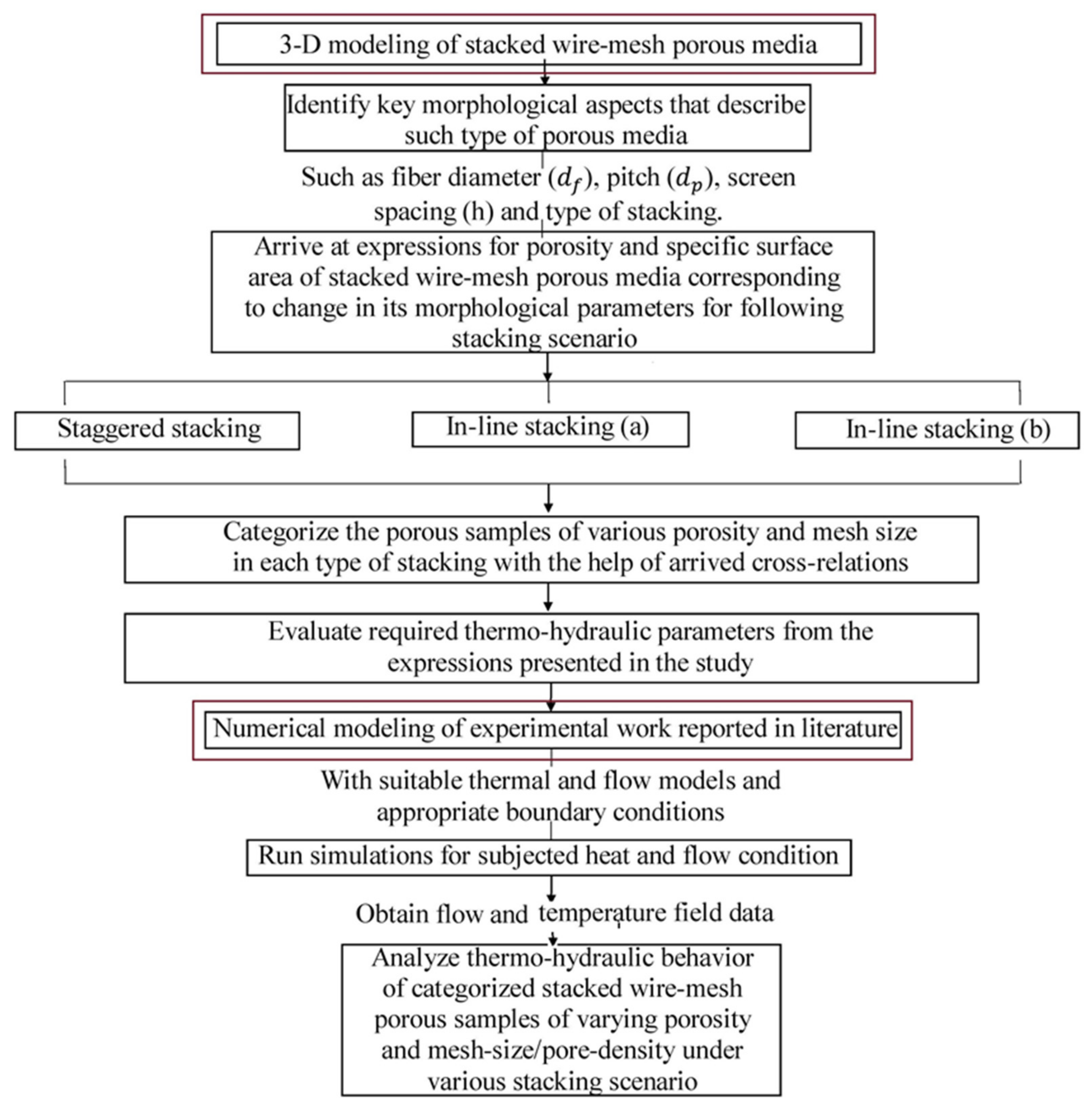

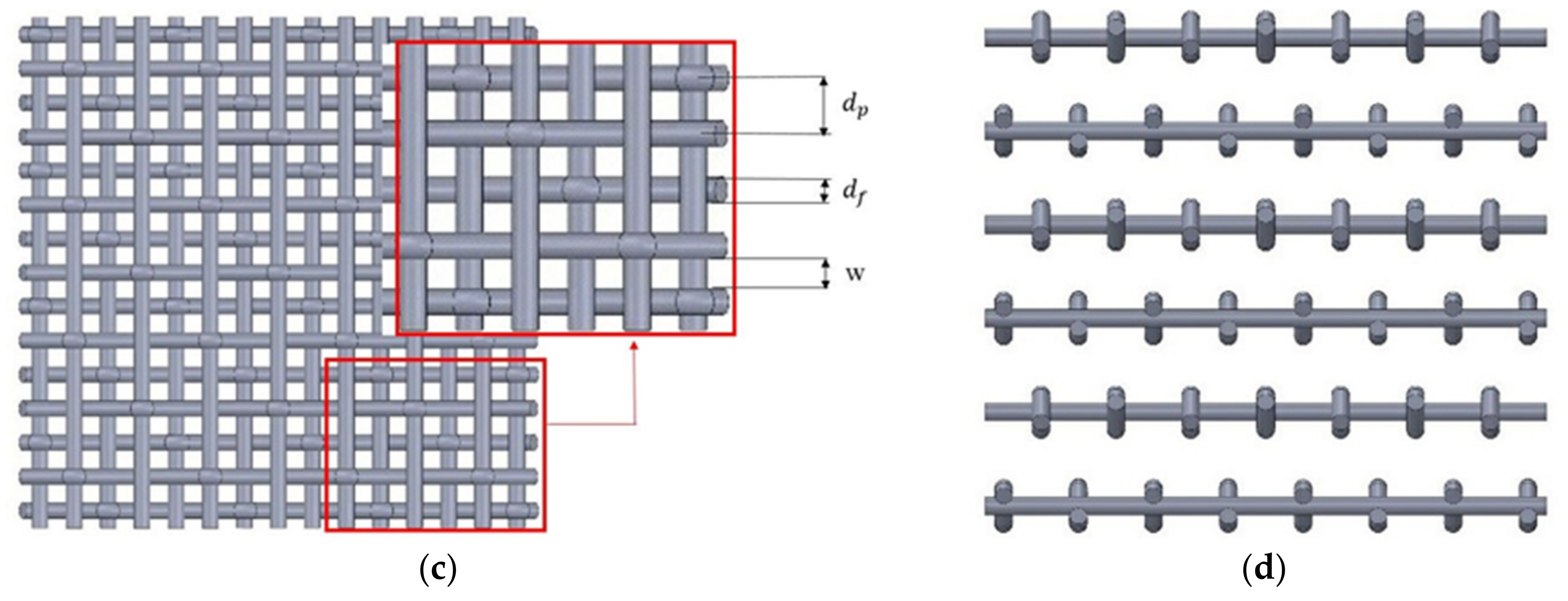



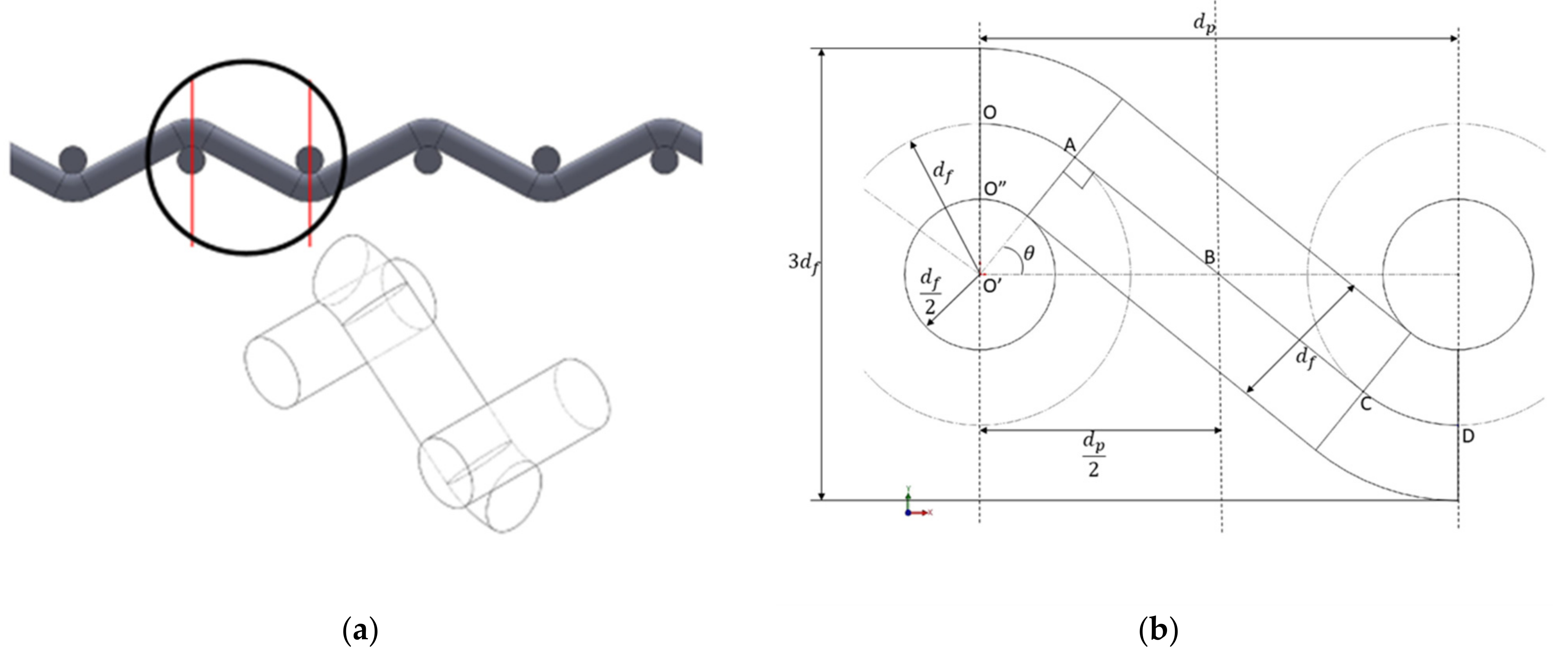
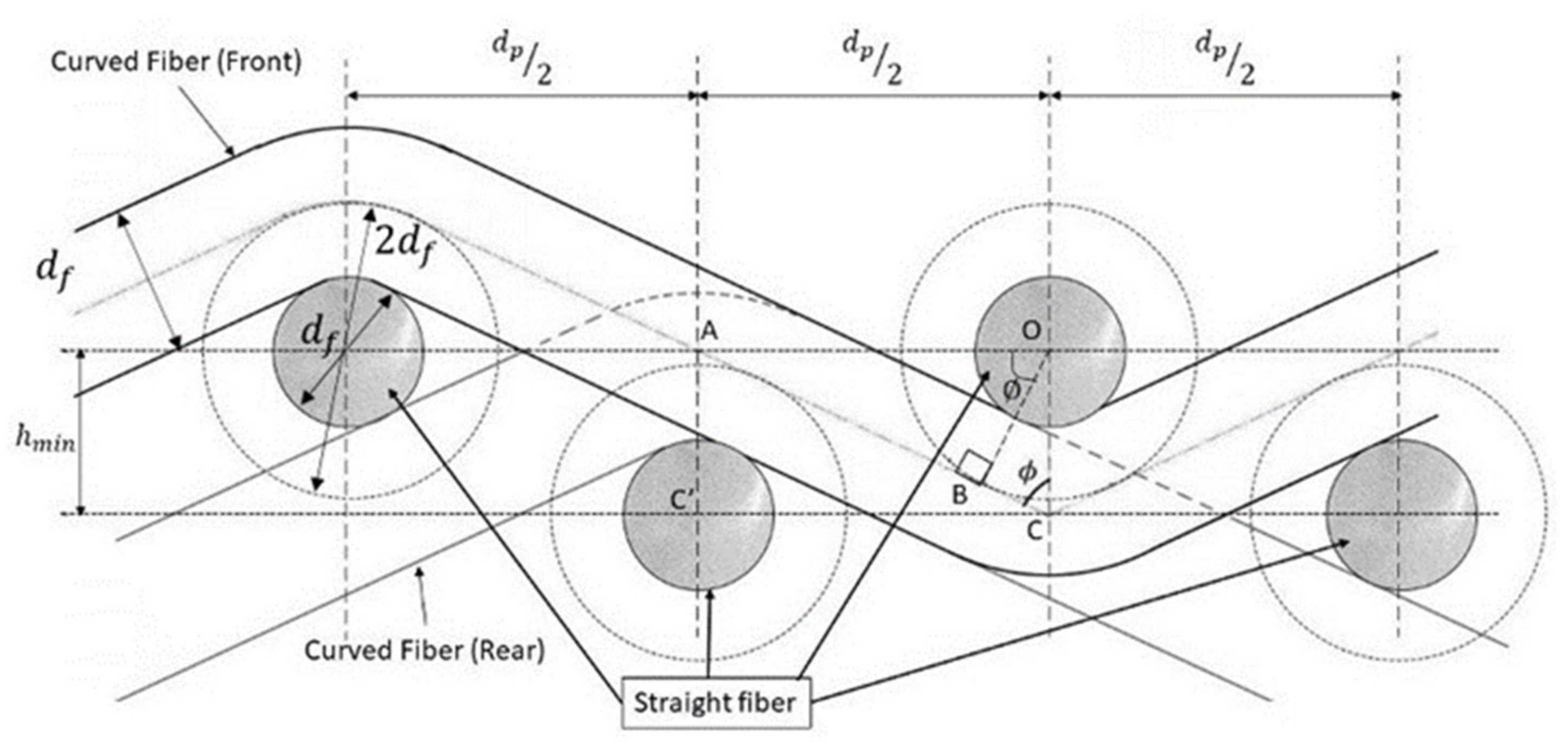
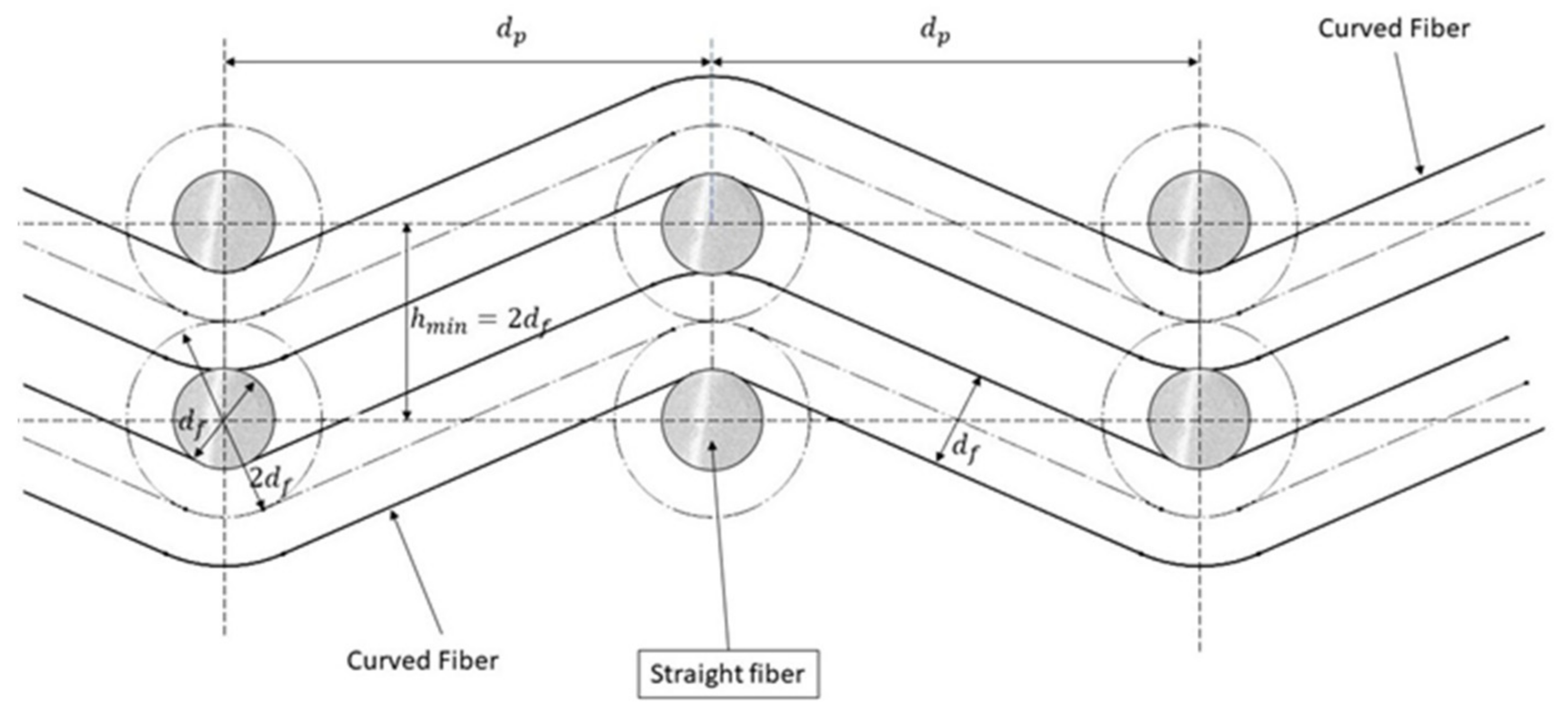
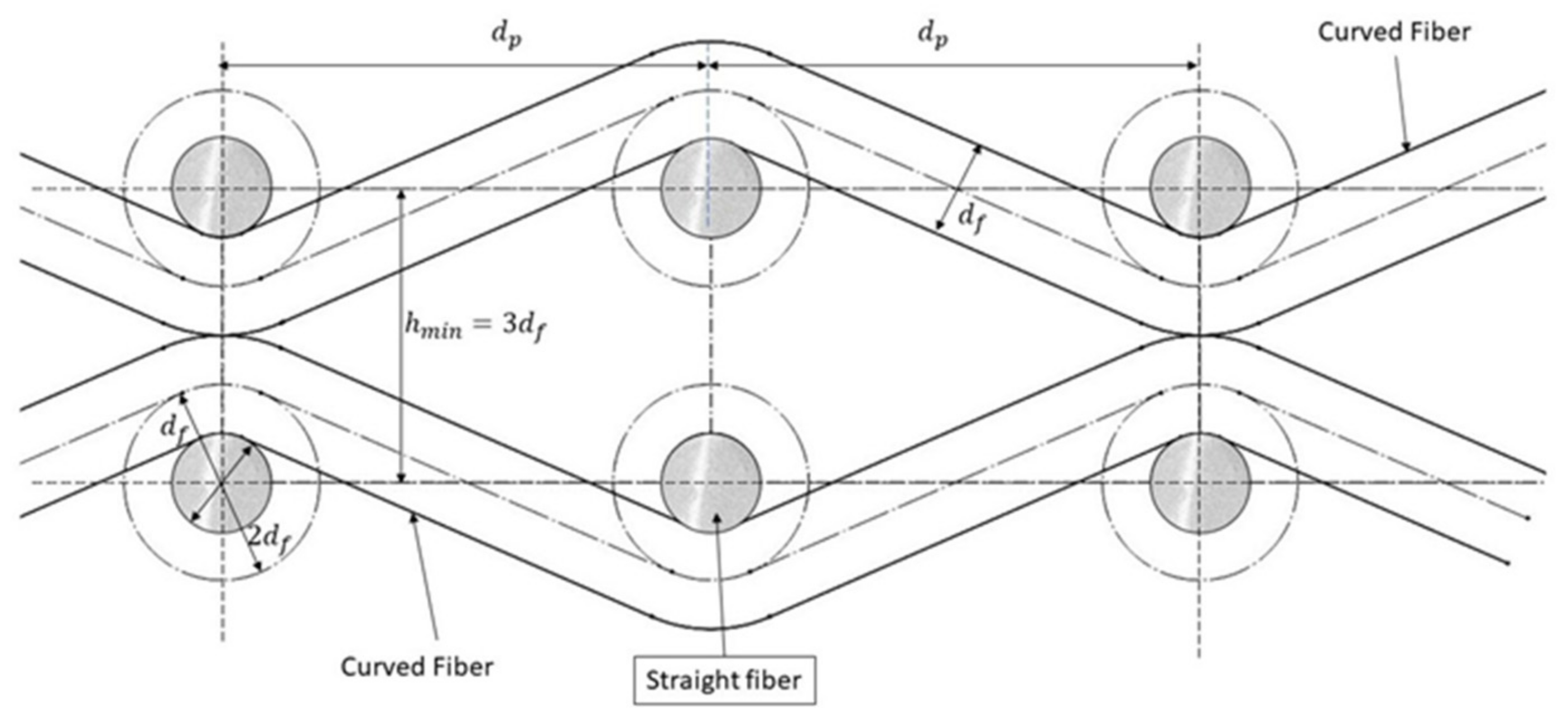
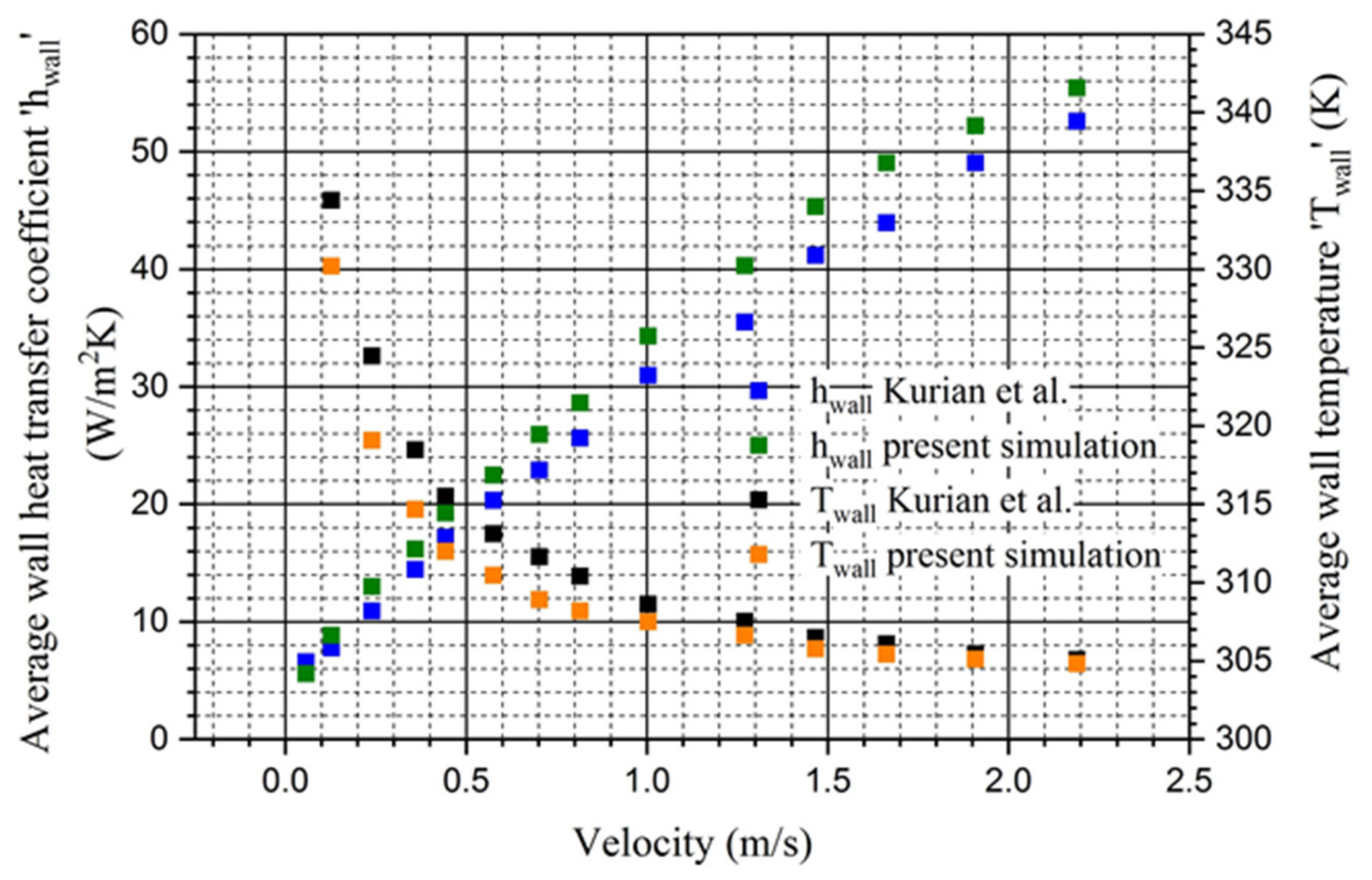
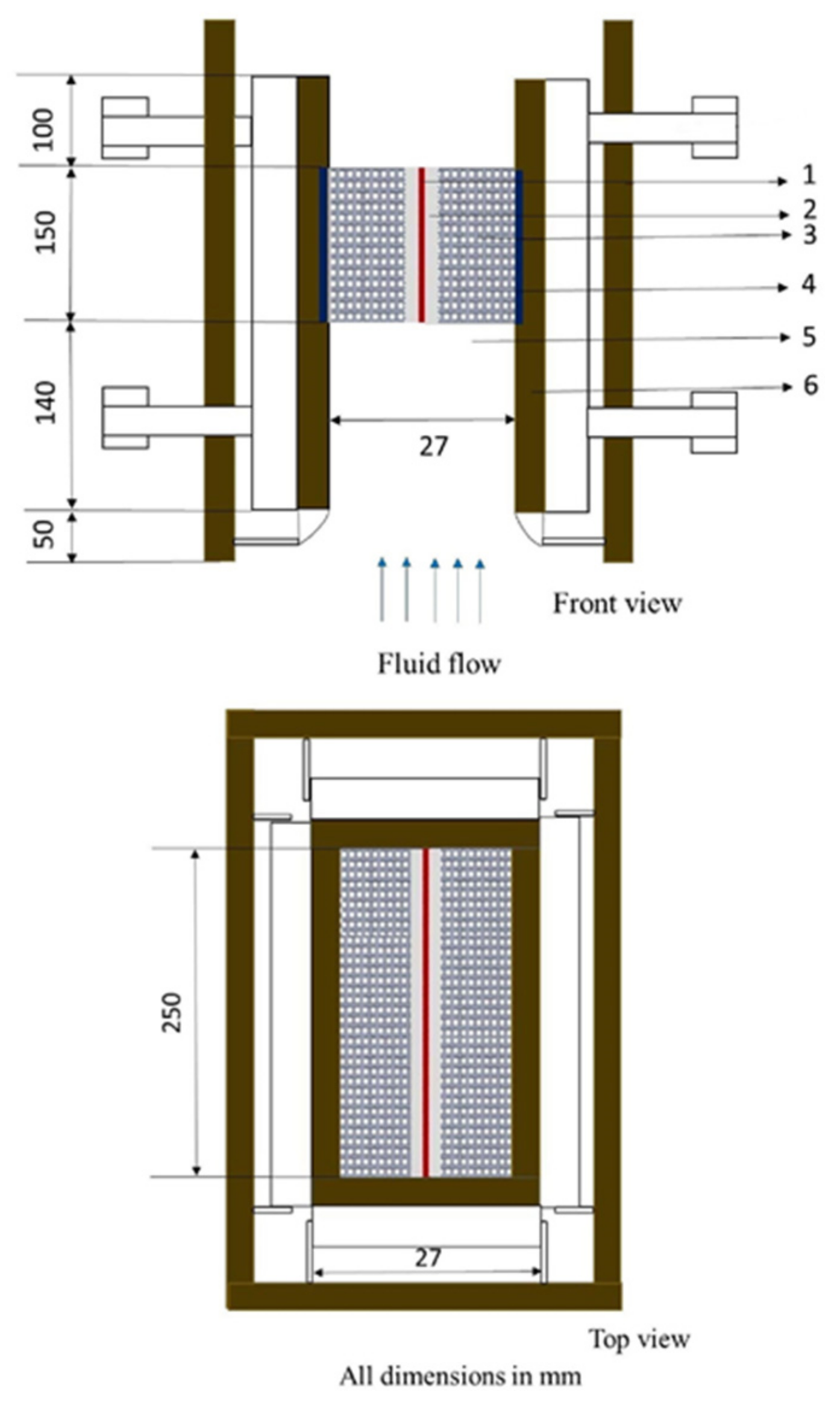
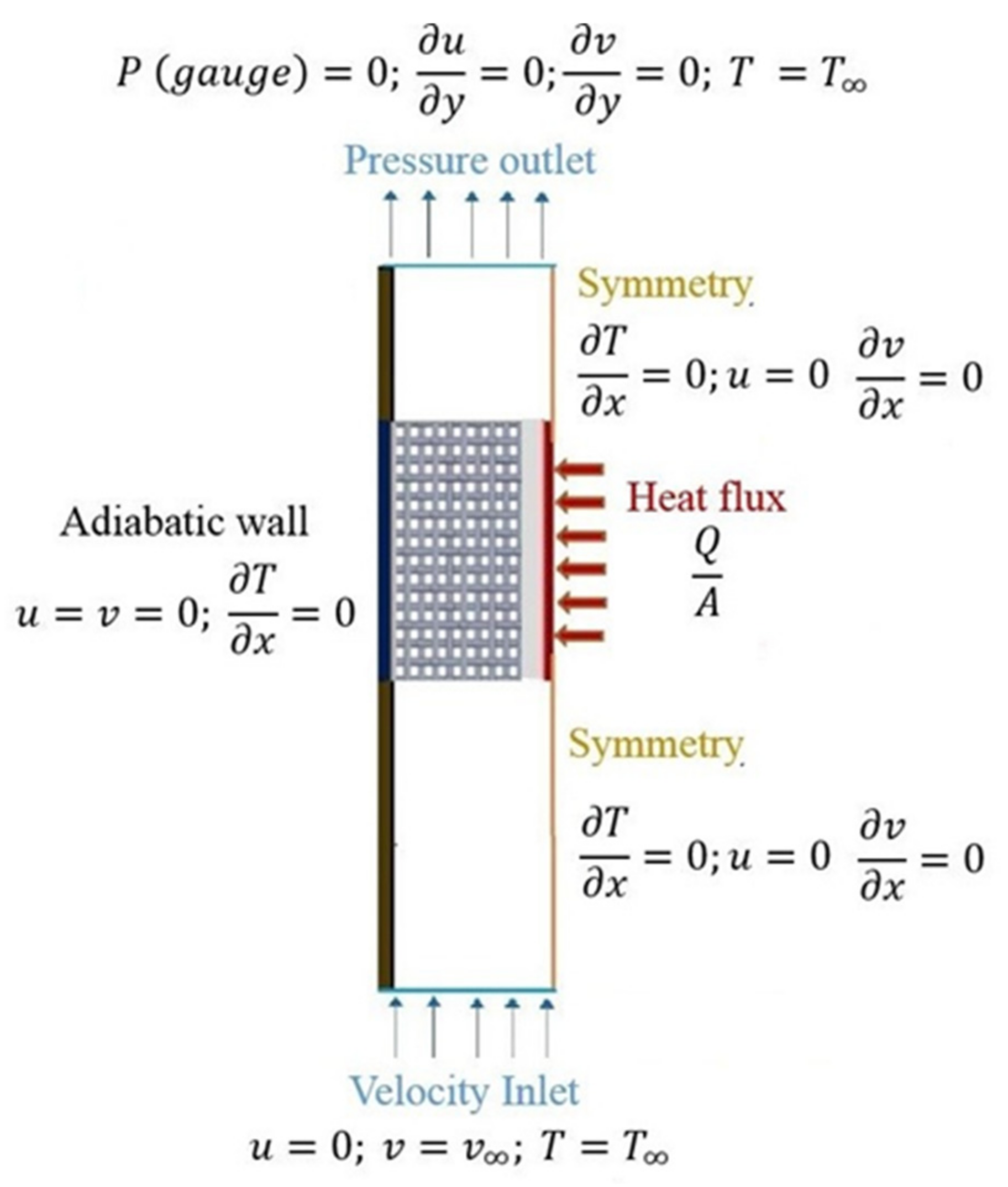
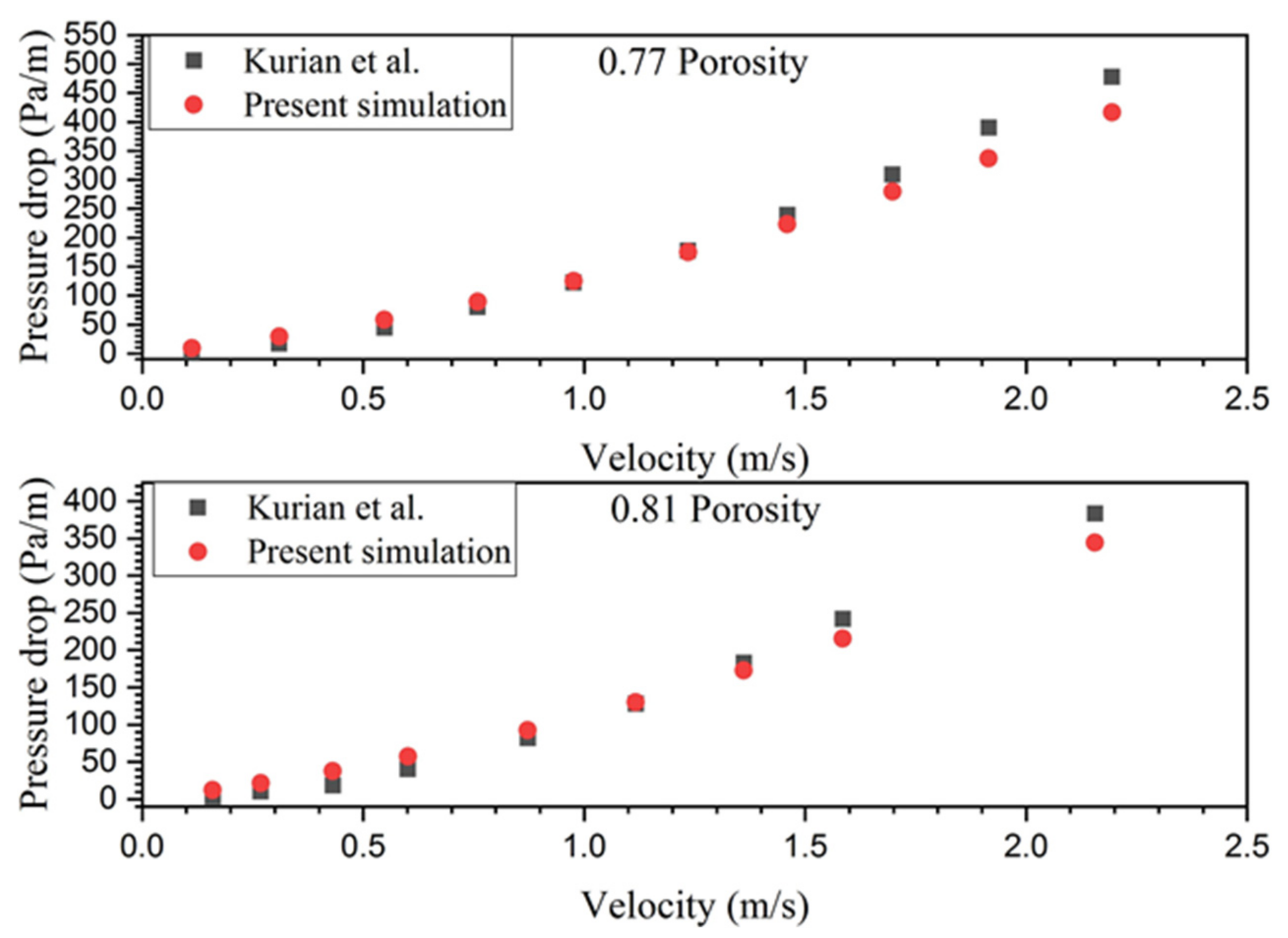
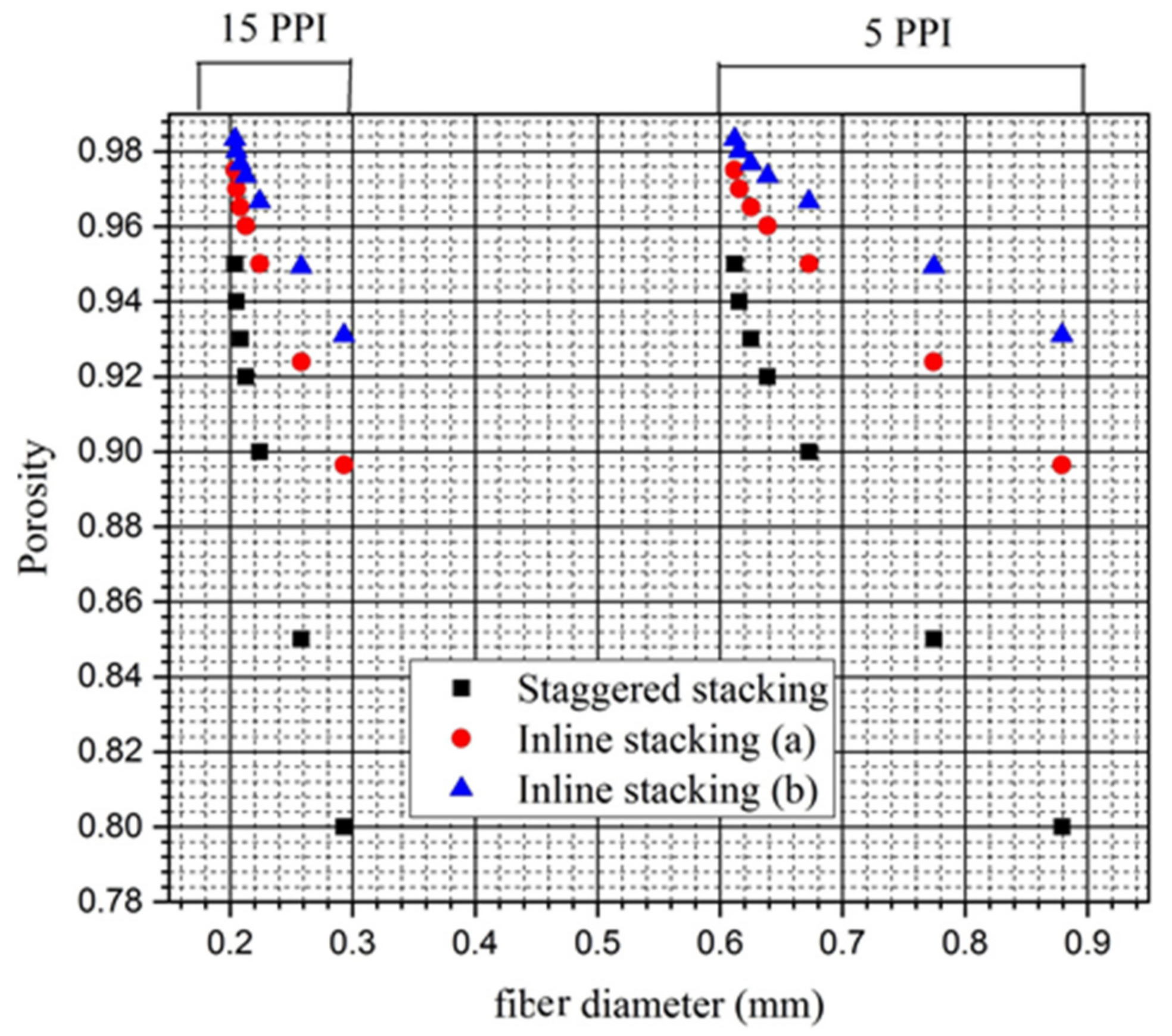
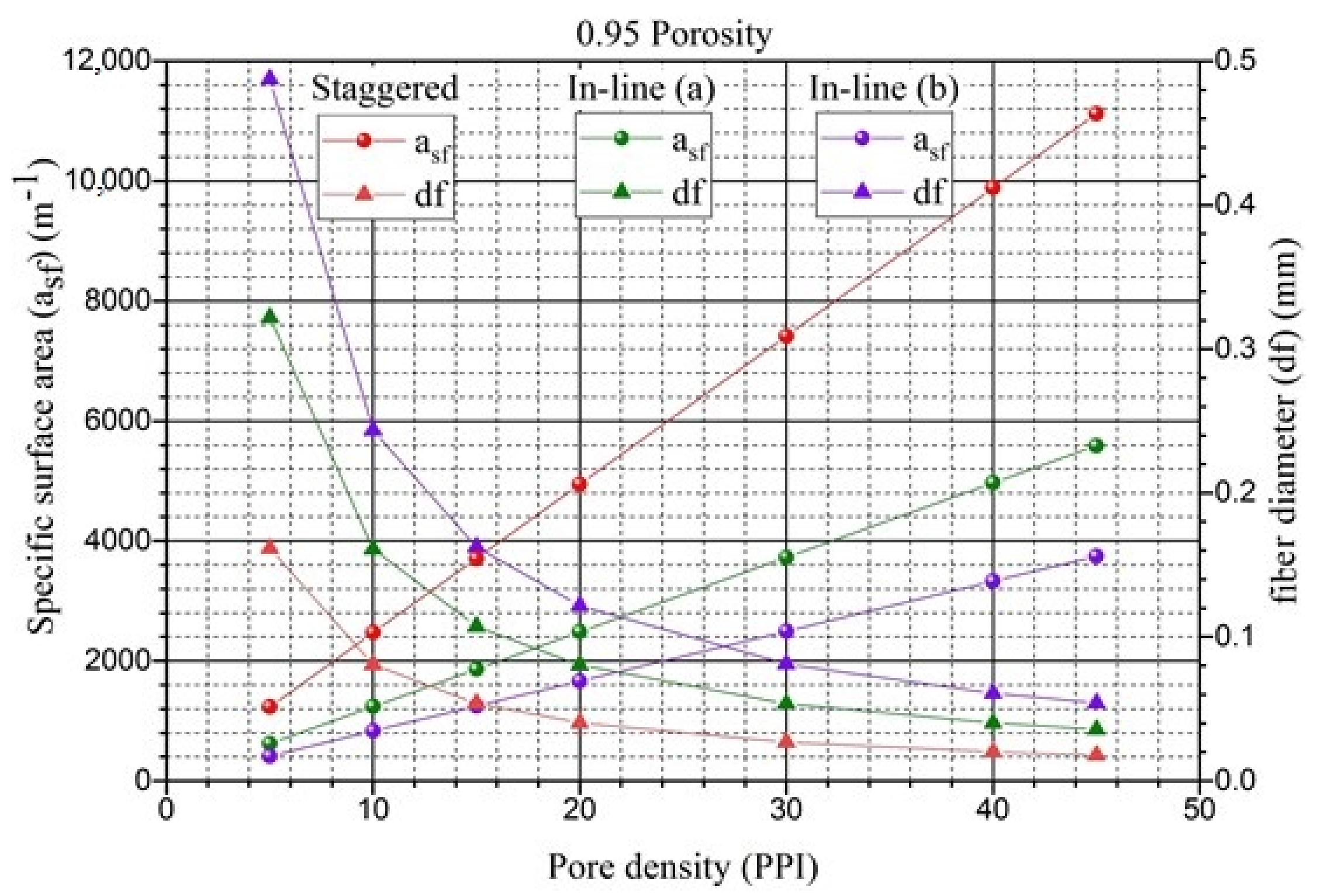
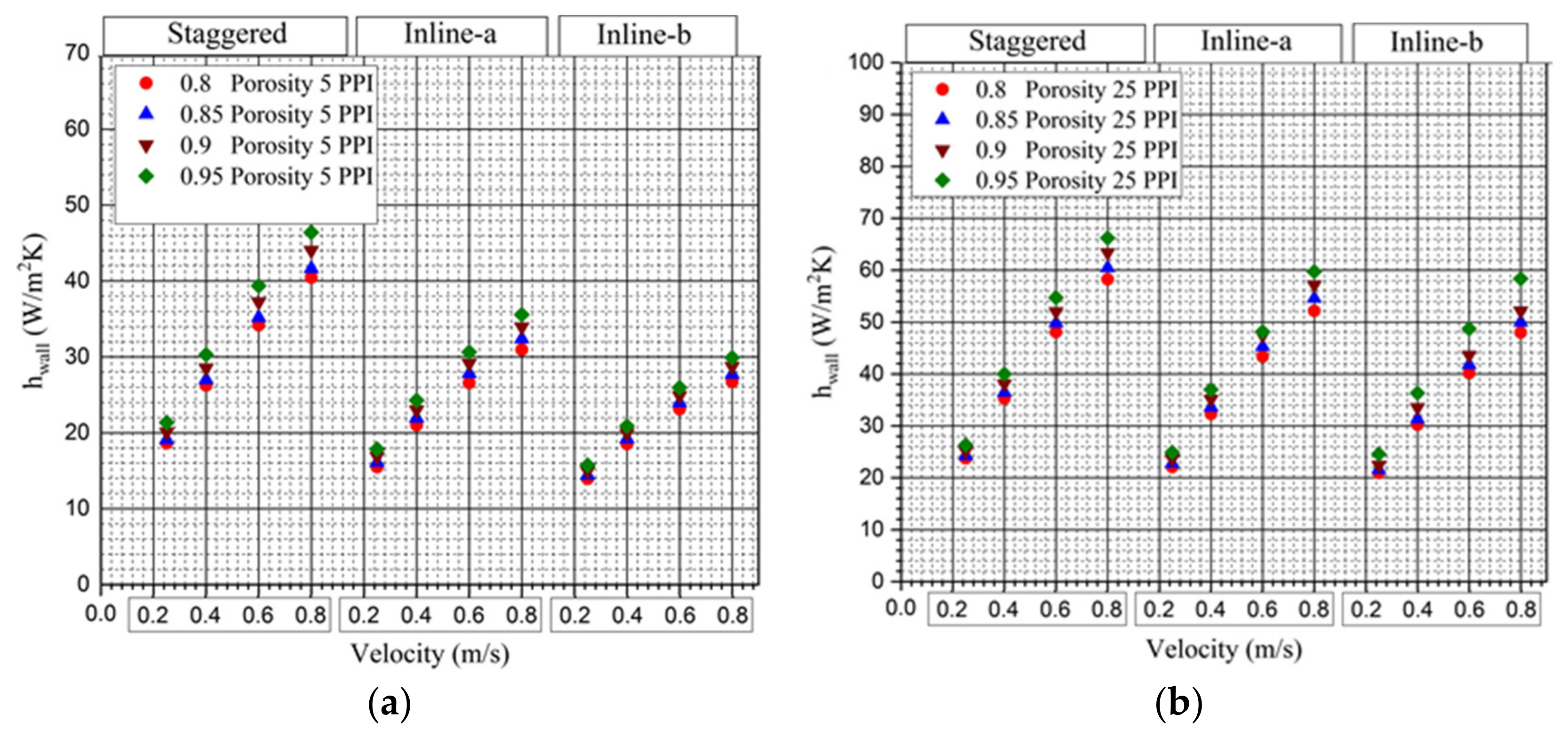
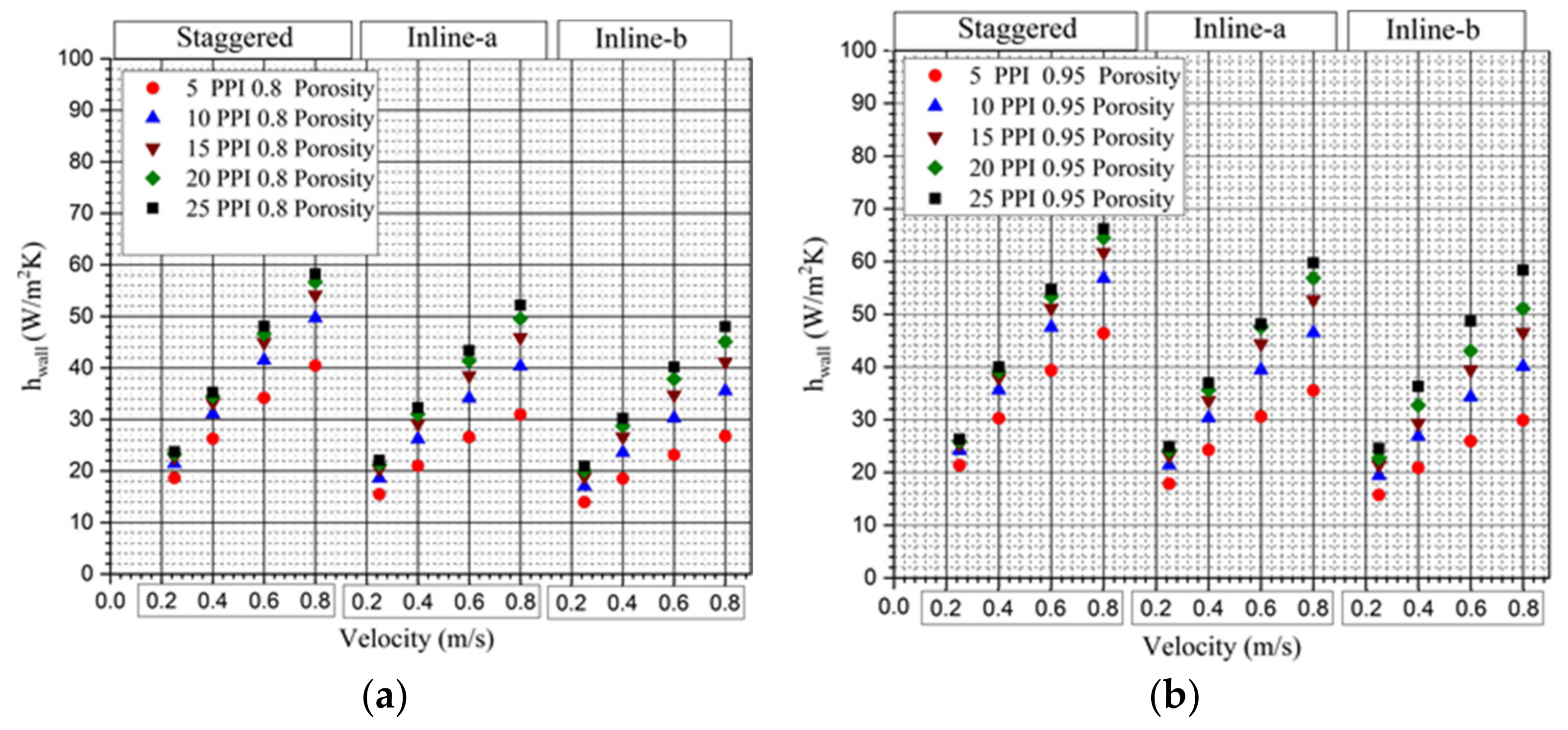
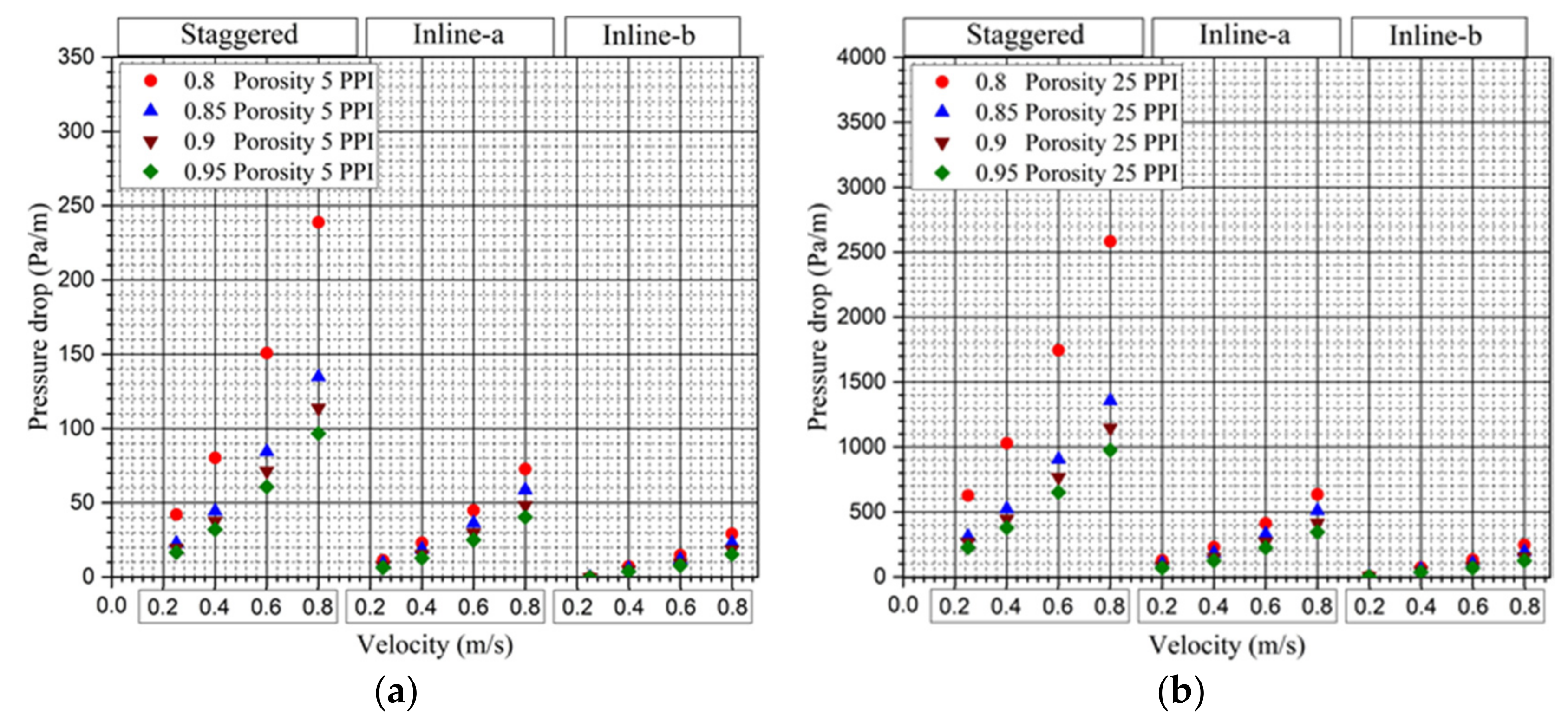
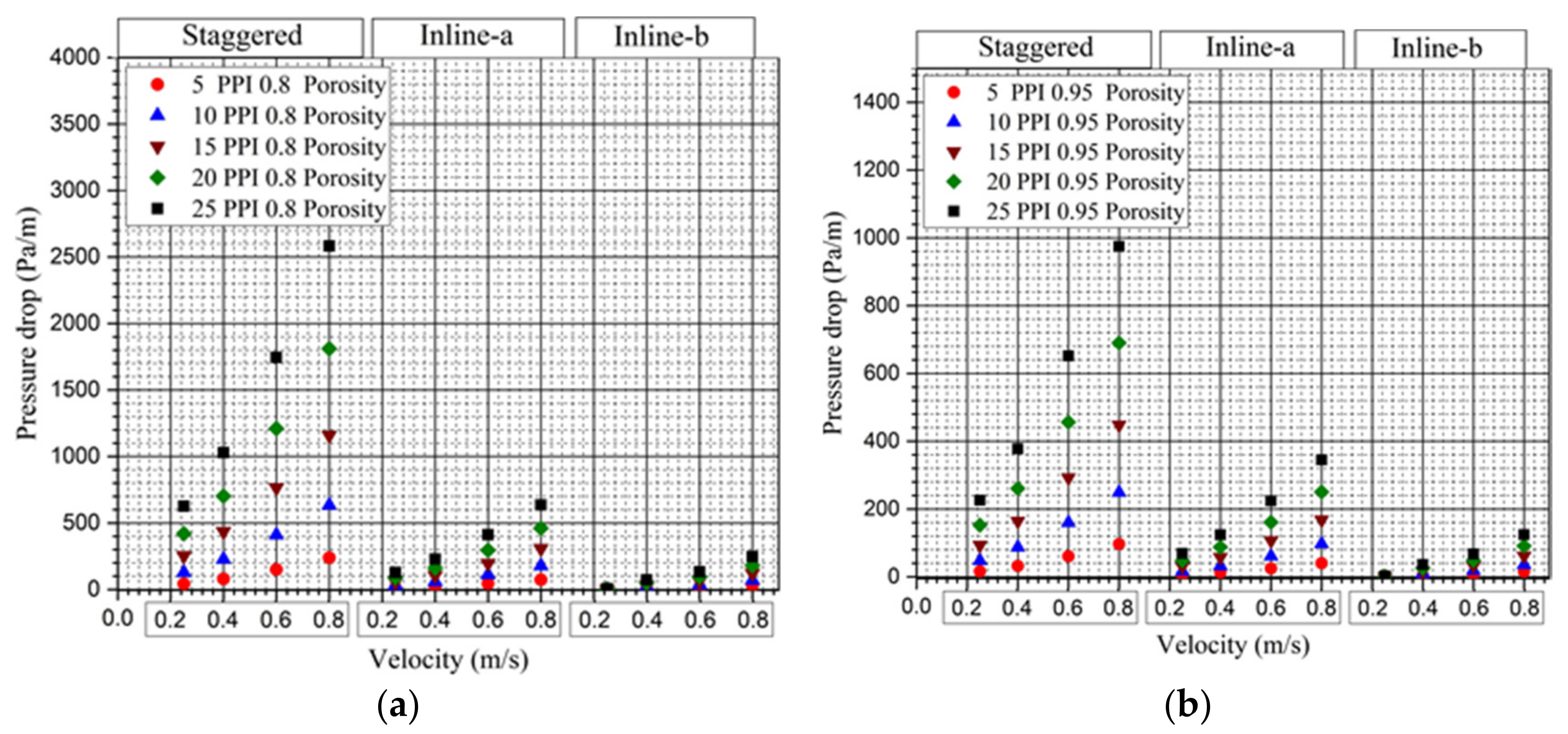
| S. No. | No. of Elements | Pressure Drop ΔP, N/m2 | Temperature Difference ΔT °C | Deviations | |
|---|---|---|---|---|---|
| ΔP, % | ΔT, % | ||||
| 1 | 26,130 | 20 | 9.75 | 2.30 | 1.10 |
| 2 | 56,700 | 19.59 | 9.69 | 0.21 | 0.43 |
| 3 | 88,400 | 19.55 | 9.65 | Baseline | |
Publisher’s Note: MDPI stays neutral with regard to jurisdictional claims in published maps and institutional affiliations. |
© 2022 by the authors. Licensee MDPI, Basel, Switzerland. This article is an open access article distributed under the terms and conditions of the Creative Commons Attribution (CC BY) license (https://creativecommons.org/licenses/by/4.0/).
Share and Cite
G, T.; Srinivas, K.E.S.; Harikrishnan, D.; N, G.; Mobedi, M. Correlations and Numerical Modeling of Stacked Woven Wire-Mesh Porous Media for Heat Exchange Applications. Energies 2022, 15, 2371. https://doi.org/10.3390/en15072371
G T, Srinivas KES, Harikrishnan D, N G, Mobedi M. Correlations and Numerical Modeling of Stacked Woven Wire-Mesh Porous Media for Heat Exchange Applications. Energies. 2022; 15(7):2371. https://doi.org/10.3390/en15072371
Chicago/Turabian StyleG, Trilok, Kurma Eshwar Sai Srinivas, Devika Harikrishnan, Gnanasekaran N, and Moghtada Mobedi. 2022. "Correlations and Numerical Modeling of Stacked Woven Wire-Mesh Porous Media for Heat Exchange Applications" Energies 15, no. 7: 2371. https://doi.org/10.3390/en15072371
APA StyleG, T., Srinivas, K. E. S., Harikrishnan, D., N, G., & Mobedi, M. (2022). Correlations and Numerical Modeling of Stacked Woven Wire-Mesh Porous Media for Heat Exchange Applications. Energies, 15(7), 2371. https://doi.org/10.3390/en15072371







